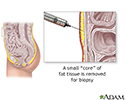Abdominal wall fat pad biopsy
Abdominal wall biopsy; Biopsy - abdominal wall fat pad
An abdominal wall fat pad biopsy is the removal of a small part of the abdominal wall fat pad.
How the Test is Performed
Needle aspiration is the most common method of taking an abdominal wall fat pad biopsy .
Aspiration
Aspiration means to draw in or out using a sucking motion. It has two meanings:Breathing in a foreign object (sucking food into the airway). A medic...

Biopsy
A biopsy is the removal of a small piece of tissue for laboratory examination.
The health care provider cleans the skin on your belly area. Numbing medicine may be applied on the area. A needle is placed through the skin and into the fat pad under the skin. A small piece of the fat pad is removed with the needle. It is sent to a laboratory for analysis.
How to Prepare for the Test
No special preparation is usually necessary.
How the Test will Feel
You may have some mild discomfort or feel pressure when the needle is inserted. Afterward, the area may feel tender or be bruised for several days.
Why the Test is Performed
The procedure is done most often to test for amyloidosis.
Normal Results
The fat pad tissues are normal.
What Abnormal Results Mean
In the case of amyloidosis, abnormal results mean there is amyloid. This is a protein that collects in tissues and impairs organ and tissue function.
Risks
There is a slight risk of infection, bruising, or slight bleeding.
References
Gertz MA. Amyloidosis. In: Goldman L, Schafer AI, eds. Goldman's Cecil Medicine . 25th ed. Philadelphia, PA: Elsevier Saunders; 2016:chap 188.
-
Digestive system - illustration
The esophagus, stomach, large and small intestine, aided by the liver, gallbladder and pancreas convert the nutritive components of food into energy and break down the non-nutritive components into waste to be excreted.
Digestive system
illustration
-
Fat tissue biopsy - illustration
Needle aspiration is the most common method of obtaining an abdominal wall fat pad biopsy.
Fat tissue biopsy
illustration
-
Digestive system - illustration
The esophagus, stomach, large and small intestine, aided by the liver, gallbladder and pancreas convert the nutritive components of food into energy and break down the non-nutritive components into waste to be excreted.
Digestive system
illustration
-
Fat tissue biopsy - illustration
Needle aspiration is the most common method of obtaining an abdominal wall fat pad biopsy.
Fat tissue biopsy
illustration
Review Date: 2/8/2015
Reviewed By: Laura J. Martin, MD, MPH, ABIM Board Certified in Internal Medicine and Hospice and Palliative Medicine, Atlanta, GA. Also reviewed by David Zieve, MD, MHA, Isla Ogilvie, PhD, and the A.D.A.M. Editorial team.


